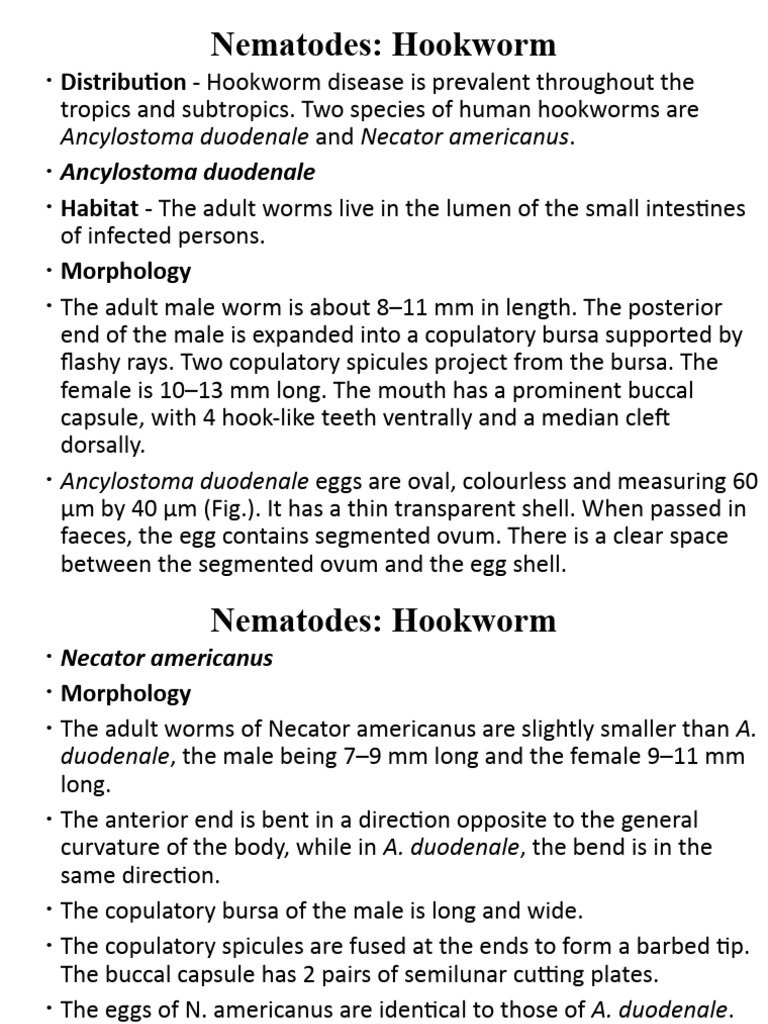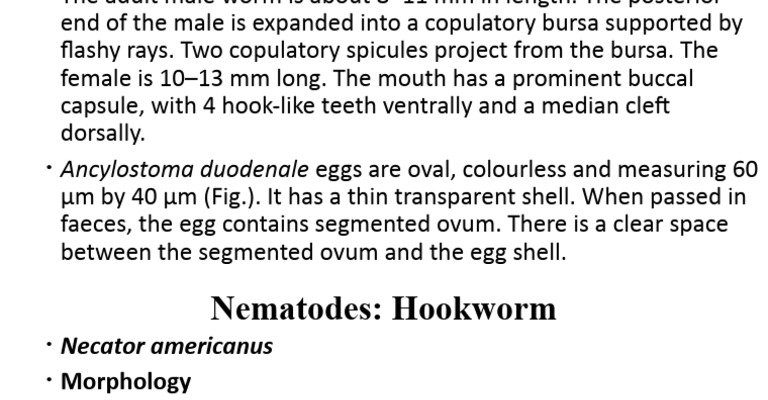
That might sound a bit daunting, but don’t worry! Let’s break down the fascinating lives of hookworms, who—or what—wants to prey on them, and how changes in their environment can shape their populations. Understanding these dynamics not only adds to our knowledge of the ecosystem but also highlights the delicate balance of life that keeps everything in check.
What Are Hookworms?
Hookworms are small, parasitic worms that primarily live in the intestines of their hosts, which include humans and animals. They belong to the family Ancylostomatidae and are known for their hook-like mouthparts, which they use to attach to the intestinal lining. This attachment allows them to feed on the host’s blood, which can lead to various health issues, including anemia and malnutrition.
There are a few types of hookworms, but the most common ones affecting humans are *Necator americanus* (the New World hookworm) and *Ancylostoma duodenale* (the Old World hookworm). They thrive in warm, moist environments, making tropical and subtropical regions their primary habitats. You might be wondering how these little guys get into the human body. Generally, it starts with direct contact with contaminated soil; for instance, when people walk barefoot in areas where hookworm larvae are present.
With such a simple entry point, it’s no surprise that hookworms are a significant public health concern, especially in areas with poor sanitation and hygiene practices.
The Role of Predators in Hookworm Populations
While it may seem like hookworms are just hanging out, enjoying a meal in their host’s gut, they face various predators in their life cycle. Some of these predators include other parasites and microorganisms that compete for the same resources.
For instance, certain bacteria and protozoa can consume these larvae in soil before they make it to a host. In addition to microbial threats, larger predators, such as certain types of nematodes and even some insects, can attack hookworm larvae in their larval stage in the environment, limiting their chances of survival.
This dynamic plays an essential role in controlling the hookworm population. Without these natural predators, you might see an unchecked boom in hookworm numbers, which would lead to more health issues for humans and animals alike. So, while it’s easy to focus on the hookworm itself, understanding its predators is crucial for grasping the overall picture of its life cycle.
How Environmental Changes Impact Hookworm Populations
Environmental factors can significantly affect hookworm populations, especially as global climate change accelerates. Warmer temperatures and increased rainfall can create ideal conditions for hookworm larvae to thrive. Since these parasites prefer moist, warm environments, regions that are getting both warmer and wetter may see an increase in hookworm infections.
Here’s where it gets interesting. Changes in land use, such as deforestation and urbanization, can further modify habitats. When forests are cut down, the soil structure changes and can become compacted, which may reduce the ability of hookworm larvae to survive. On the other hand, urban areas with poor sanitation can create hotspots for these parasites, allowing them to spread more easily.
Overall, environmental changes can either create opportunities or challenges for hookworms. Monitoring these changes becomes essential for public health efforts aimed at controlling infections.
Human Activity and Hookworm Survival
Humans play a double-edged sword when it comes to hookworms. On one hand, our behaviors can create more environments conducive to hookworm transmission. Poor sanitation practices are chief among these. When people defecate in open areas or in soils that are eventually used for growing crops, they inadvertently contribute to the spread of hookworms.
On the flip side, various control measures can help manage hookworm populations effectively. Proper sanitation, regular deworming programs, and public health education can drastically reduce infection rates. You might be surprised at how simple measures can make a significant impact. For example, ensuring that children wear shoes in endemic areas can help reduce infections.
These proactive measures highlight that while human activity can inadvertently increase hookworm populations, it can also be part of the solution.
Climate Change and Its Effect on Hookworms
It’s no secret that climate change poses a threat to many aspects of our environment, and hookworms are no exception. As temperatures rise and weather patterns shift, the habitats suitable for these parasites are likely to expand. Researchers have observed that with climate change, regions previously considered too cold for hookworms are now becoming more hospitable.
This potential spread of hookworms can have dire consequences for public health. The more areas that hookworms invade, the more at-risk populations there are. Additionally, increased rainfall can lead to more contaminated soil, further enhancing transmission opportunities.
If you’re thinking about how this impacts you and your community, consider that awareness and preparedness can help mitigate these risks, making it crucial to keep a keen eye on how changing climates affect health trends.
The Balance of Life: Hookworms and Their Ecosystem
Understanding hookworms goes beyond just their predators and environmental threats. These parasites play a role in the broader ecosystem. For one, they serve as indicators of ecological health. A decrease in hookworm populations might suggest improvements in sanitation and overall public health.
Moreover, the hunt for equilibrium in nature is ongoing. Each species, including hookworms, has its role. Healthy predator-prey dynamics help maintain a balance that can prevent any one species from monopolizing resources. By understanding the complexity of these relationships, we can appreciate the need to protect biodiversity.
Let’s think of ecosystems as intricate webs. When one thread is pulled—like an increase in hookworm populations or a decrease in their predators—the whole structure can wobble. The balance is delicate, requiring keen observation and intervention when things start to slip.
What Can Be Done to Address Hookworm Populations?
Addressing hookworm populations requires a multi-faceted approach that combines public health measures, community awareness, and environmental management. Here are some crucial steps that can help.
- Education: Raising awareness about hookworms, their transmission, and prevention methods is vital.
- Sanitation Improvements: Investing in proper sanitation facilities can drastically reduce transmission.
- Deworming Programs: Communities should implement regular deworming for at-risk populations, especially children.
- Monitoring Ecosystems: Keeping an eye on both hookworm populations and their predators can help inform necessary interventions.
By working together, communities can create a healthier environment for everyone, minimizing the threat of hookworms while ensuring their natural predators can thrive as well.
In conclusion, the world of hookworms is a complex one, filled with fascinating interactions between species and their environments. While these small parasites can pose serious health risks, understanding their predators and the environmental threats they face can lead to better management strategies—keeping our ecosystems balanced and our populations safe. So, the next time you enjoy a stroll outdoors, remember the unseen world beneath your feet and the intricate dance of life it holds.

